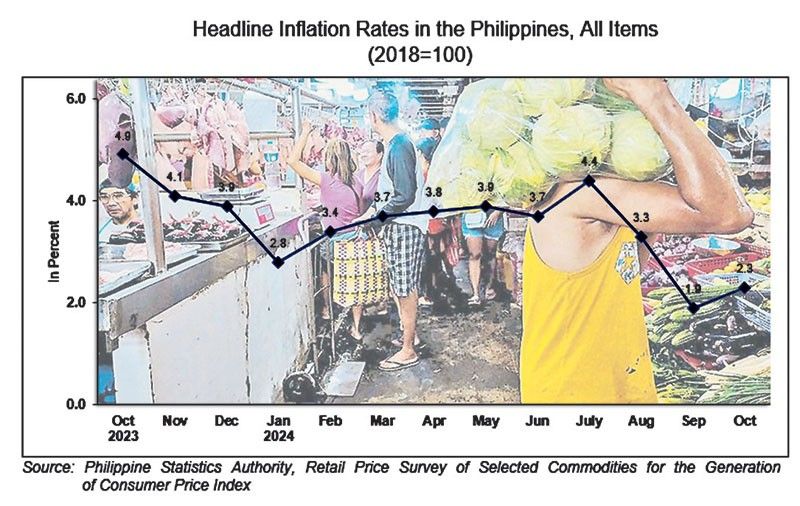Inflation quickens to 2.3% in October

MANILA, Philippines — Inflation accelerated in October, breaking a two-month downtrend, as food items registered faster increases, according to the Philippine Statistics Authority (PSA).
In a press briefing yesterday, PSA head Dennis Mapa said headline inflation – the rate of increase in average prices of consumer goods and services – quickened to 2.3 percent in October from 1.9 percent in September.
The October inflation print, however, is lower than the 4.9 percent posted in the same month last year.
The Bangko Sentral ng Pilipinas (BSP) said the October inflation result is within its two to 2.8 percent forecast range for last month.
Mapa said the uptrend in October inflation was primarily driven by the faster uptick in food and non-alcoholic beverages at 2.9 percent during the month, from 1.4 percent in September.
Inflation for food alone went up to three percent in October from the previous month’s 1.4 percent.
Driving the higher food inflation was rice, which had a faster inflation of 9.6 percent in October from 5.7 percent in September despite reduced tariff on rice imports.
Mapa attributed the faster rice inflation to base effects, with rice prices posting slow increases in October last year due to the imposition of a price cap.
He said the average prices of rice have declined month-on-month across all three types tracked by the PSA.
The price of regular milled rice went down to P50.22 per kilo in October from P50.47 per kilo in September, while the price of well-milled rice dipped to P55.28 per kilo from P55.51 per kilo in the prior month. Average price of special rice also dropped to P60.97 a kilo in October from the previous month’s P64.05 per kilo.

“Our expectation is that this (rice inflation) has already peaked. This (October rice inflation) is just a blip and we expect to go down, inflation rate and price level per kilo in the coming months,” Mapa said.
Aside from food, he said transport, which had a slower decrease of 2.1 percent in October from a 2.4-percent drop in September, also drove the higher overall inflation last month.
Average inflation for the January to October period is at 3.3 percent, still within the BSP’s two to four percent target range for the year.
“The latest inflation figures confirm that we are on track to keep inflation within target. The government is fully committed to ensuring price stability and protecting Filipino households from undue shocks,” National Economic and Development Authority (NEDA) Secretary Arsenio Balisacan said.
The BSP said the latest inflation outturn is in line with its assessment that inflation will continue to trend closer to the low end of the target range over the succeeding quarters.
“Nonetheless, the balance of risks to the outlook for 2025 and 2026 has shifted toward the upside. Upside risks to the inflation outlook could emanate from the potential adjustments in electricity rates and higher minimum wages in areas outside Metro Manila, while downside factors continue to be linked to the impact of lower import tariffs on rice,” the BSP said.
To ensure price stability and support sustainable economic growth and employment, the BSP said the Monetary Board will maintain a measured approach in its easing cycle.
As recent weather disturbances, including Severe Tropical Storm Kristine, have posed significant challenges to the country’s food supply and logistics, Balisacan said the government is working relentlessly to ensure the availability of food and keep prices steady.
“With targeted support and streamlined food supply chains, we aim to ensure that food is affordable and accessible for Filipino families, especially those most vulnerable to price shocks when disasters hit us,” he said.
The Philippine Atmospheric, Geophysical and Astronomical Services Administration expects La Niña to persist until the first quarter of next year, with two to eight tropical cyclones expected to affect the country until April 2025.
To mitigate the impact of natural disasters, the NEDA said the government, particularly, the Department of Social Welfare and Development is implementing the Building on Social Protection for Anticipatory Action and Response in Emergencies and Disasters Program, that provides social safety nets and capacity-building measures to help affected communities.
“The President has mobilized all of the government to ensure relief efforts are comprehensive and delivered on time. In addition, he has directed us to craft a robust solution to build the resilience of families and communities amid the onslaught of severe typhoons,” Balisacan said.
- Latest
- Trending





























